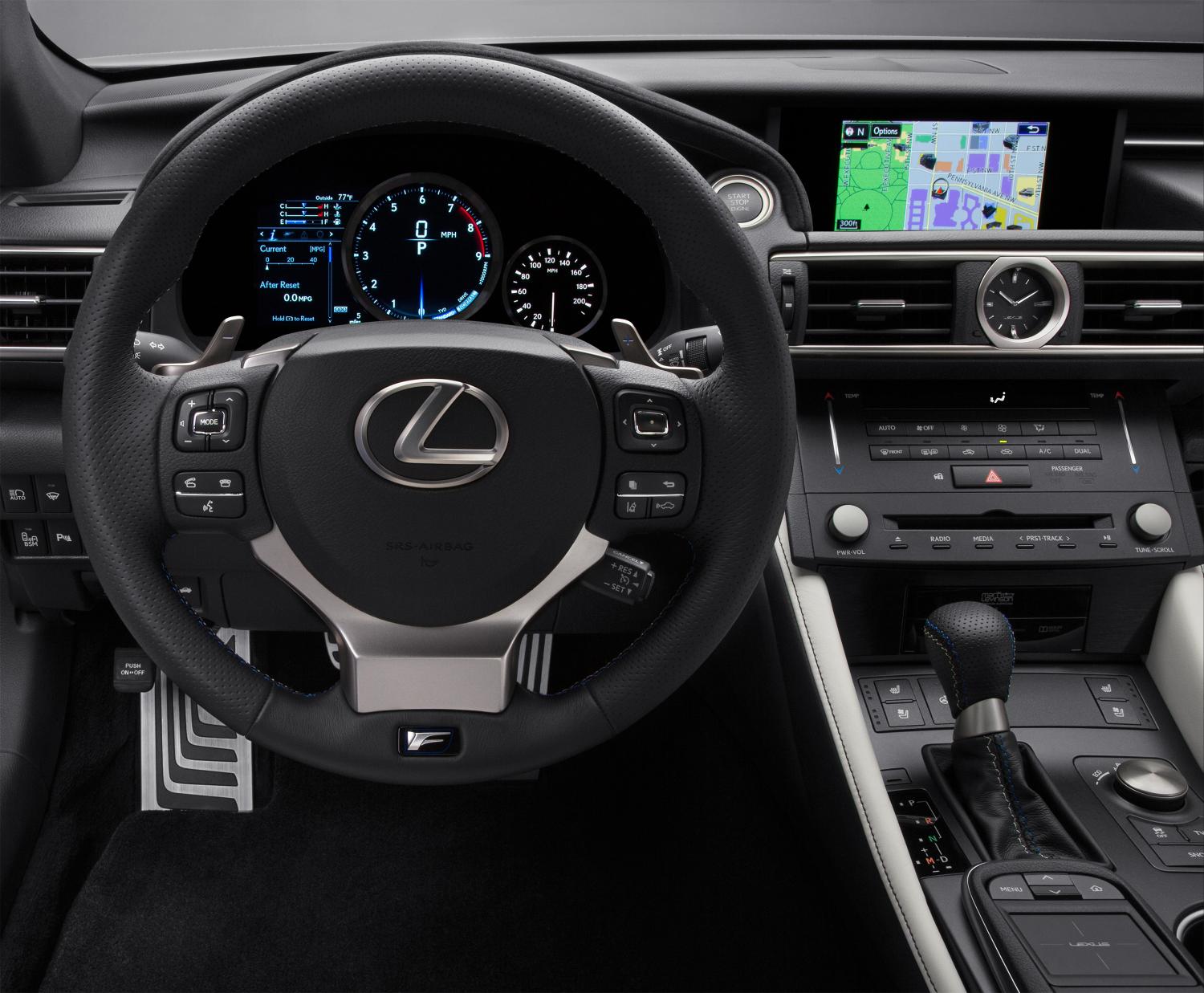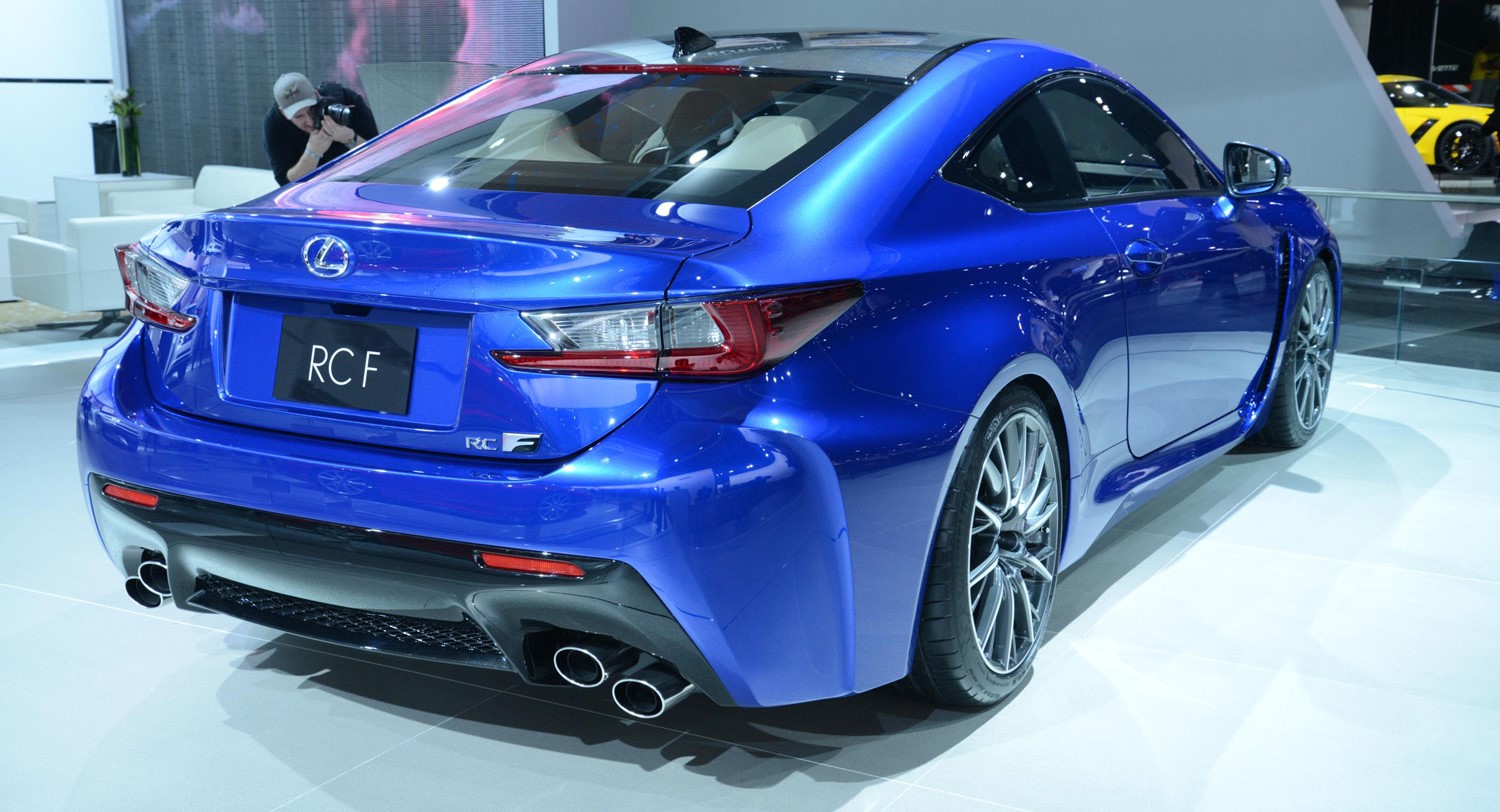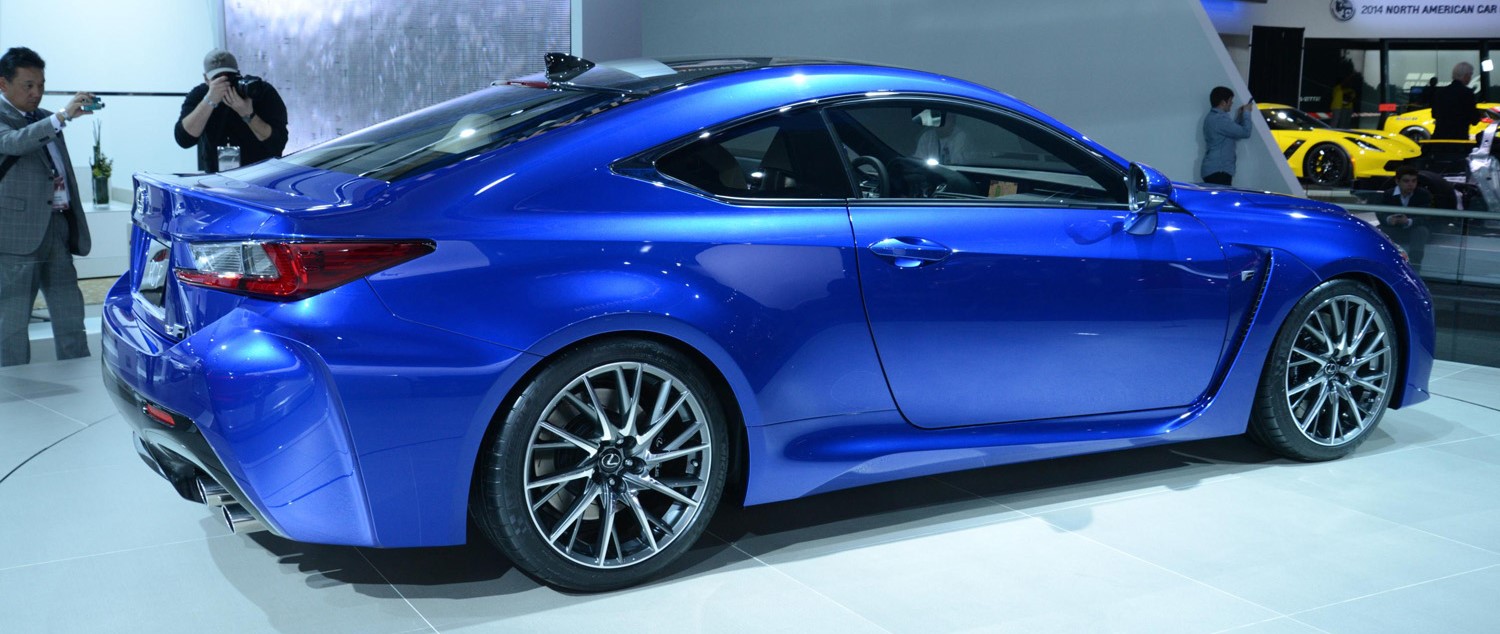
ALL-NEW LEXUS RC F PERFORMANCE COUPE
- Lexus’ Most Powerful V8 Engine Generates More than 450 Horsepower
- Latest Iteration of the F Marque in a Coupe Bodystyle
- Lexus-First Use of Torque Vectoring Differential for Incredible Cornering
- Purpose Designed Instrumentation and Sport Seats
Driving Dynamics with More Power and Usability
The RC F has an all-new 5.0-liter 32-valve V8 engine that will provide increased maximum power at higher engine rpm than previously possible. For the first time in a Lexus performance engine, the RC F uses the Atkinson cycle at cruising speeds for enhanced fuel economy and then switches to the Otto cycle at higher rpm to develop impressive performance levels.
Driver engagement has been made possible by purpose designed sound and power delivery. A uniquely tuned eight-speed Sports Direct Shift (SPDS) transmission improves linear throttle response.
It helps the driver control the torque and power precisely as it is applied.
The newly calibrated VDIM adds a vertical G-sensor to provide greater vehicle stability
Torque Vectoring Differential
The RC F uses a Torque Vectoring Differential (TVD), a first in a Lexus, to increase driving performance. It has three operating modes:
- Standard for a balance of nimble performance and stability;
- Slalom for emphasis on nimble steering response; and
- Track to help with consistent stability, ensuring the vehicle stays on the intended corning line as the driver applies more throttle.
Handling
The foundation for the vehicle’s mechanical grip is the highly rigid body with large cross-section rocker panels and a very stiff front lower brace. Specialized Lexus manufacturing techniques are also used, including body adhesives, laser-screw welding, laser brazing and multi-spot welding. Grip is further enhanced through use of a wider tire and wheel assembly.
RC F has front and rear coil-spring independent suspension, with monotube gas-filled shock absorbers and ball-jointed stabilizer bars. Unsprung weight is reduced by the adoption of three new 19-inch diameter forged aluminum wheels which minimize tire/wheel assembly mass and maximize rigidity.

Exterior Design
Lexus RC F adds to the stylish body of the new RC coupe on which it is based. The RC F features its own version of the Lexus signature spindle grille which dominates the front of the vehicle from hood line to lower lip. The grille has a subtle F-mesh pattern on the lower half.
In profile view RC F has a unique front hood which raises the peak of the vehicle, creating a powerful side view.
The RC F takes design cues from the Lexus LFA supercar, especially in essential air cooling and aerodynamics. Its hood air vent, such as those on the LFA, combined with front cooling ducts contribute to engine cooling and overall vehicle stability.
As in the LFA, an active rear spoiler is incorporated into the trunk lid to provide down force at speeds of more than 50 mph. The active spoiler is a highlight of RC F’s aerodynamic package which includes careful tuning of the underbody, the intakes in the grille and the front fender vents, and strategic placement of the aero stabilizing fins.
To the side, front fender ducts in the shape of an L also aid cooling performance while adding to the aggressive stance.
The RC F’s available carbon fiber package offers a clear coated carbon fiber roof and active rear spoiler drawn from the LFA production experience.

Interior Design
Uniquely designed components, including combination meters, the steering wheel, seats, ornamentation and pedals, convey a sense of connection with the driver that only a Lexus F performance model can achieve.
RC F’s all-new combination meters are further developed from LFA while also referencing aircraft cockpit instruments. The meters provide a wide range of easy to read information for the various drive modes.
The combination meters include a large centrally mounted tachometer that alters according to drive mode, digital and analog speedometer, differential torque vectoring monitor, G-Force meter, oil and water temperature gauges, mileage information and a stopwatch.
The driver’s connection to the RC F is paramount. The RC F debuts a Lexus-first elliptical cross-section thick grip steering wheel for greater control during performance driving. The placement, shape and operation of paddle shifters make it easier to change gears on the track and in other performance circumstances.
The all-new high back seats have been designed for exceptional holding performance. An integrated foaming technique creates a highly supportive and taut fitting seat with trim material that stays fixed.

| 2015 Lexus RC F | |
| Horsepower | More than 450 hp |
| Torque | More than 383 lb.-ft. |
| Transmission | Eight-speed Sports Direct Shift (SPDS) |
| Seating Capacity | 4 |
| Overall Length | 185.2 in. |
| Width | 72.8 in. |
| Height | 54.7 in. |
| Wheelbase | 107.5 in. |
| Driven Wheels | Rear Wheel Drive |
| Curb Weight | Targets less than 3,968 lbs. |
| Brake Type | Four-wheel power assisted disc brakes (Brembo manufactured for Lexus) with Anti-lock Braking System (ABS) and Electronic Brake force Distribution (EBD) and Brake Assist (BA) |
| Wheel size (front and rear) |
Fr 19” x 9” Rr 19” x 10” |
| Tires size | Fr 255/35/19 Rr 275/35/19 |
| 0 – 60 mph | Targets faster than IS F |
| Top speed | Estimated 168 mph (electronically limited) |
| MPG (City/Hwy/Comb.) | Targets better than IS F |


RC F: THE MOST POWERFUL LEXUS V8 PERFORMANCE CAR YET
- RC F equipped with Lexus’ most powerful V8 engine to date, generating in excess of 450bhp
- World-first use of a Torque Vectoring Differential in a front engine/rear-wheel drive sports car
- Powerful exterior styling, incorporating advanced, race-bred aerodynamics
- Bespoke interior with RC F-dedicated instrumentation, seats and finishes
- Debut at the North American International Auto Show on the 25th anniversary of the launch of the Lexus brand
- Full RC F gallery here
The high-performance Lexus RC F makes its European debut at the 2014 Geneva motor show, ahead of its launch in late 2014.
The great visual impact of the RC F is matched by the impressive power of its new 5.0-litre engine. Generating well in excess of 450bhp, it makes the RC F the most powerful V8 performance model Lexus has yet produced.
To harness the engine’s potential with the best possible efficiency, the RC F uses a newly calibrated eight-speed transmission and, in a world first for a front engine/rear-wheel drive car, a Torque Vectoring Differential to secure higher levels of traction and vehicle control.
Yukihiko Yaguchi, RC F Chief Engineer, said: “I’ve built the RC F to be enjoyed by all enthusiasts, no matter what their level of expertise. There’s a false perception that racing cars are hard o drive. In fact, they’re easy in the right hands because they’ve been purpose-built for the skill level of their drivers. It’s the same with the RC F. Electronics can be modified instantly on board to provide appropriate levels of performance and protection. But even at its basic setting, it’s a blast!”
All-new High Performance Engine
At the heart of the new RC F is a 5.0-litre 32-valve engine developing more than 450bhp and 520Nm of torque. Its cylinder heads and all moving parts have been newly designed to deliver more power at higher engine revs than has previously been possible.
It is also the first Lexus performance engine to use the Atkinson cycle at cruising speeds, to secure better fuel economy, switching to the Otto cycle at higher revs to achieve impressive levels of performance.
The engine has been developed exclusively for the RC F and every aspect of the powertrain has been designed to deliver the highest possible driver engagement, including the transmission and exhaust system.
The specially calibrated eight-speed Sports Direct Shift transmission improves linear response to accelerator pedal inputs, giving the driver more precise control of power and torque delivery.
The RC F driving experience is further heightened by a new system that regulates induction and exhaust sound, creating a deep tone up to 3,000rpm, and a higher-pitched note as revs rise beyond 6,000rpm under hard acceleration.
Torque Vectoring Differential
The RC F marks a world-first for a front engine/rear-wheel drive car with its use of a Torque Vectoring Differential. Designed to raise driving enjoyment by increasing traction and control, the system has three operating modes: –
- Standard, for a balance of agile performance and high-speed stability
- Slalom, for an emphasis on nimble response to steering inputs
- Track, for consistent, stable cornering in circuit driving, with optimum driver control. The RC F also has a recalibrated Vehicle Dynamics Integrated Management system with an additional vertical G-force sensor to secure even greater vehicle stability.
Driving Dynamics
The foundation of the new RC F’s outstanding mechanical grip is its highly rigid body, featuring large cross-section rocker panels and front lower brace. Lexus has deployed numerous specialist manufacturing techniques to further enhance rigidity, including the use of body adhesives, laser-screw welding and multi-spot welding. A wider tyre and wheel assembly help to raise grip performance.
Independent, coil-sprung suspension is used front and rear, incorporating monotube gas dampers and ball-jointed anti-roll bars. The car’s unsprung weight has been kept down by using 19-inch forged aluminium alloy wheels, which minimise wheel assembly mass while at the same time improving rigidity.
As in the Lexus LFA supercar, the RC F is fitted with an active rear wing, Incorporated in the bootlid, this provides additional downforce at speeds above 50mph. The rear wing is a highlight of the RC F’s comprehensive aerodynamic grip and stability package, which also includes tuning of the flat underbody, race-bred air management ducts behind the front bumpers and wings, and strategic placement of aero stabilising fins.
F performance styling
The RC F is immediately distinguishable from the RC coupe thanks to its more powerful visual impact.
It features its own interpretation of the Lexus signature spindle grille, which dominates the front of the vehicle and has a subtle ‘F’ motif embedded in the mesh below the Lexus badge.
The front of the bonnet is set higher than on the RC, creating a powerful, flared profile that’s in keeping with its status as a Lexus F model. The profile view is rendered more striking by the 10-spoke 19-inch forged aluminium wheels, three versions of which will be available, including one that’s hand-polished by craftsmen.
The design takes some cues from the LFA, most notably in the use of essential air cooling and aerodynamic features. Air outlets on the bonnet, like those on the LFA, work together with front cooling ducts to support both engine cooling and overall vehicle stability.
To the side there are air outlets behind the front wings that add to the engine and brake cooling performance, and which merge neatly with side sill extensions to create a powerful ‘L’ shape.
The powerful look continues at the rear of the car, with stacked, quad trapezoidal exhaust outlets.
Lightweight carbon fibre package
Lexus drew on the experience it gained with the LFA and the IS F CCS-R race car to develop a package of carbon fibre parts that help keep the RC F’s weight to a minimum. The carbon fibre elements include the roof, bonnet and active rear wing.
Interior design
The RC F’s interior is driver focused and equipped with numerous components specific to the model, including the instrument meters, steering wheel, seats, pedals and trim, all designed to deliver the kind of comfort, support and ergonomics expected of a high-performance Lexus F model.
The instrument meters mark a further development of the switchable, diving mode-dependent central dial featured in the LFA. The design is inspired by aircraft cockpit instrumentation, providing a wide range of information in a clear, concise form that can be read at a glance.
The instrumentation includes a large, centrally mounted tachometer which changes according to driving mode; digital and analogue speed read-outs; a differential torque vectoring monitor; a G-force meter; oil and coolant temperature gauges; mileage information; and a stopwatch.
Lexus has also worked to provide an ergonomically ideal driver-machine interface. The RC F marks Lexus’ first use of a thick-grip steering wheel with an elliptical cross-section, design to provide greater control during performance driving. The location, shape and action of the paddle shifts have also been carefully determined to enable fast, accurate gear changes at all times.
The seat designs, with styling influenced by modern close-fitting sportswear, feature high backs that use Lexus’ integrated foaming technique to provide excellent support, eliminating any movement between the seat padding and trim.
Lexus RC F Preliminary Technical Specification
| Engine capacity (l) and configuration | 5.0 V8 |
| Max. power (bhp/kW) | ˃450/335 |
| Max. torque (Nm) | ˃520 |
| Transmission | 8-speed Sports Direct Shift, intelligent electronically controlled automatic |
| Driven wheels | Rear-wheel drive |
| Seating capacity | 4 |
| Overall length (mm) | 4,705 |
| Overall width (mm) | 1,850 |
| Overall height (mm) | 1,390 |
| Wheelbase (mm) | 2,730 |
| Kerb weight (kg) | ˂1,800 (target) |
| Brakes | Power-assisted Brembo discs |
| Wheels | Front – 19 x 9J
Rear – 19 x 10J |
| Tyres | Front – 255/35R19
Rear – 275/35R19 |
| 0-62 mph | Faster than IS F |
| Estimated top speed (mph) | 168 (electronically limited) |
| Estimated fuel consumption | Better than IS F |
